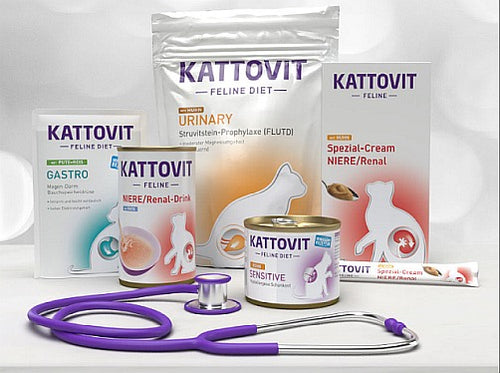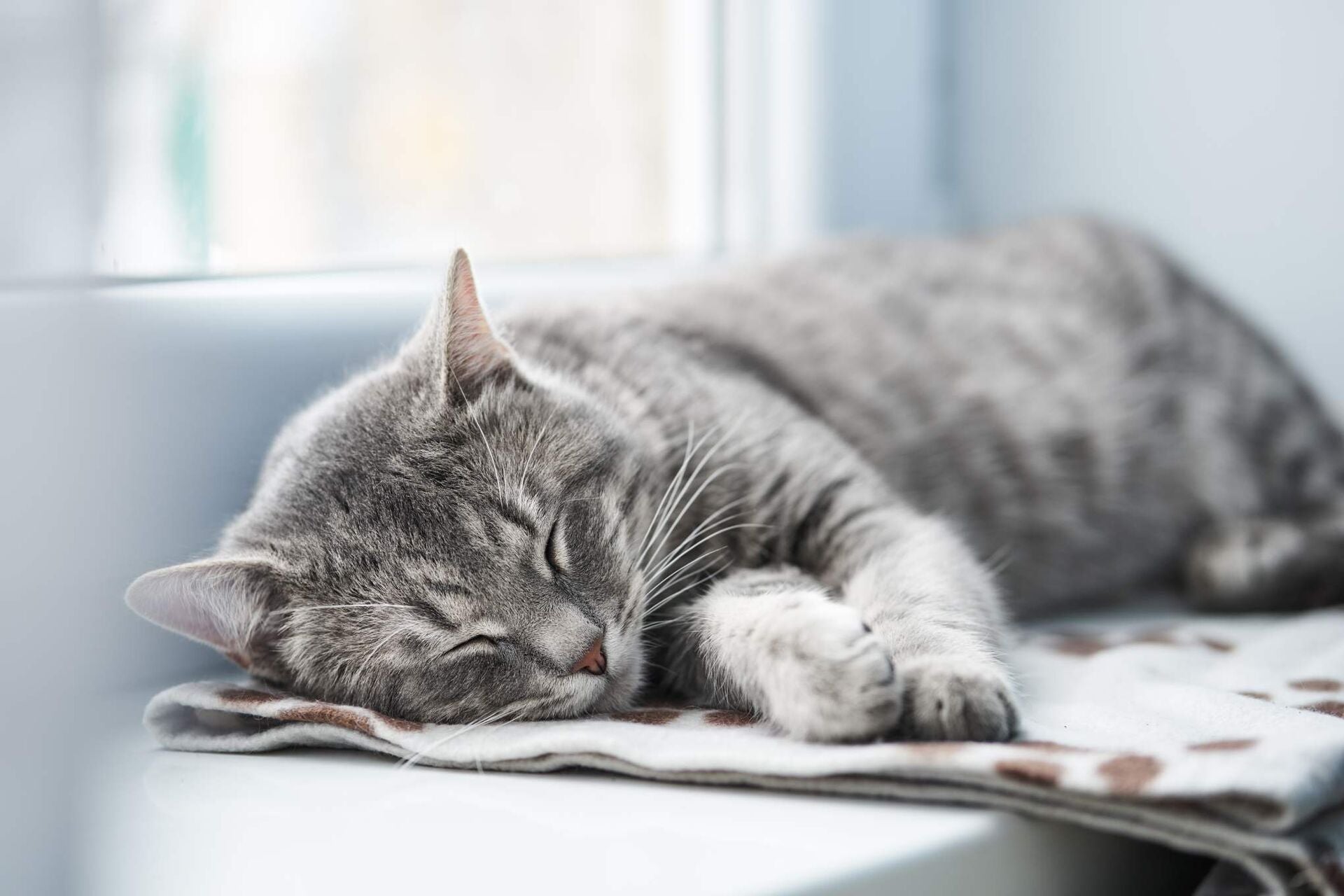Cat does not recover after anesthesia: cause for concern?
When your four-legged friend has to undergo an operation, the owner is often very worried: Will the procedure be without complications? Will the animal tolerate the anesthesia? Will the healing process go according to plan? Once the operation is over, you will initially feel relief. But when you get home, doubts arise: The animal is still dazed and is behaving strangely. You become worried and increasingly have the feeling that your cat is not recovering from the anesthesia. When you should pay attention and see a vet, which symptoms and behaviors are normal in cats after anesthesia and how you can best care for your house cat during and after the recovery phase - you can read all this and more here.
[Aufbaukur]
Anesthesia in cats: General information on the procedure
During anesthesia, the cat is put into an artificial sleep which prevents it from being aware of anything. This means that all types of intervention – from castration to dental treatment to heart surgery – can be carried out without the animal experiencing pain, moving or anything similar. The anesthetic can be administered in a variety of ways. The most common are inhalation or intubation anesthesia , where the agent gets into the lungs via breathing, and so-called TIVA anesthesia , which uses a venous catheter. Injection anesthesia is also still frequently used in many veterinary clinics; here the agent gets directly into the muscles or veins via a syringe.
Once the procedure is complete and the wound has been treated, the veterinarian begins the waking phase . Depending on the type and duration of the anesthesia, it can take different amounts of time for the animal to be awake and conscious again. During this phase, the cat is usually still in the veterinary clinic or practice to be under professional supervision. However, you as the owner are often informed early on and called in to give the little patient a feeling of security and to accompany them as they wake up in the unfamiliar clinic environment as a calming influence and reference person .
Cat after anesthesia: behavior after waking up
If no noticeable complications occur during the recovery phase and the surgical wound has been cared for appropriately, you can take the patient home in the transport box. Even though the cat has now recovered from the operation and anesthesia, many animals still have to deal with the after-effects for a while.
fatigue and body temperature
In the first few hours after the anesthesia, it is completely normal for your cat to be tired , perhaps even groggy . Above all, the animal needs rest and warmth during this stage, as the body has a lot to process and is not yet able to regulate its own temperature due to the artificial deep sleep. A warm bed and a cozy spot in a quiet room - preferably in the transport box - provide a good basis for the cat to recover properly after the anesthesia and move on to the recovery phase.
Difficulties with orientation, coordination and swallowing
If your pet begins to explore its surroundings, it may experience problems with orientation and coordination. A staggering gait , a confused look , stumbling and swaying can characterize the first few hours after anesthesia. The lack of coordination also affects the cat's swallowing mechanism , which it may not yet be able to control. Therefore, only offer your house cat food when the after-effects of the anesthesia have worn off enough that the four-legged friend can move in a coordinated manner and without difficulty. Otherwise, there is a risk that the animal will choke and panic or even have difficulty breathing.
nausea and vomiting
Occasionally, the anesthetic causes nausea in cats. If animals that have just been neutered or have undergone another operation have to vomit after their first meal, this is not necessarily a cause for concern. Often the first meal simply came a little too early and the cat would have needed a little more time to recover from the anesthesia and to sort out its stomach and intestines. This applies equally to all organs: spontaneous emptying of the bladder is also possible in the first few hours.
Regular duration of anesthesia symptoms
As a rule, the symptoms described should not last longer than 24 hours after anesthesia. After this period, the cat still needs time and rest to recover from the operation, but the anesthesia should have completely worn off by now.
By the way : If your pet suffers from a dry cough or mucous sputum as a result of inhalation anesthesia, there is usually no need for action. Such symptoms are due to the intubation and can last for several days , but are harmless.
If in the days following the anesthesia you feel that your cat is still weak and perhaps needs some support to get back on its feet, a temporary change to a special diet may help. The KATTOVIT nutritional supplement was developed by specialists to help furry friends get back on their feet. However, you should still consult your veterinarian - also to rule out the possibility that there is something more serious behind it.
[Aufbaukur+Sensitive]
Cat does not recover after anesthesia: risks & side effects
Nonetheless, as with any medical procedure, occasionally a cat may not recover after anesthesia. So if 24 hours have passed and you are still noticing changes that are concerning, it is likely that either the surgery itself or the anesthesia is related to these abnormalities.
In this case, you should take your observations seriously and contact your veterinarian immediately. This is because an anesthetic risk can manifest itself in a wide variety of symptoms - and in the worst case, can cause illness or even death.
The tricky thing is that personality changes such as apathy and lethargy, as well as loss of appetite and failure of individual body parts or sensory functions, often only appear as secondary symptoms - they can therefore be causally related to the anesthesia, but their origin is often not clear to the owner. If you notice such abnormalities, it is urgently time to visit the vet. And there are also some other phenomena that can occur in rare cases as a result of anesthesia.
Bruises and inflammation at the injection site
Intravenous anesthesia and injection anesthesia can cause bruising or inflammation in the area of the injection site. These can appear in the form of redness and other discolorations, swelling, pustules or the formation of pus . Although such consequences of anesthesia can be harmless, if you suspect a serious injury you should quickly consult a veterinarian who will take a closer look at the situation.
If treated promptly, most damage caused by injection needles can be repaired with appropriate medication and proper wound care. However, if an infection is left untreated , germs can spread and enter the bloodstream, which can cause organ damage or even blood poisoning . To avoid another operation and permanent damage, you should observe the cat after the anesthesia and, if in doubt, seek veterinary help.
tissue and nerve damage
In rare cases, injections can lead to abscesses or irritation of the affected nerves, veins or surrounding tissue , which can expand, worsen and persist after the operation. Such damage is often temporary and resolves on its own. However, there is a risk of persistent pain, paralysis, dying tissue and skin regions or permanent nerve damage with serious consequences such as (partial) blindness. To rule out such consequences of anesthesia, you should immediately seek the advice of an expert even in the event of minor abscesses, irritation or failure, or changes in personality or behavior.
shortness of breath and respiratory disorders
As a rule, breathing problems only arise if an inhalation anesthetic has been administered beforehand. While coughing, sputum and even a slight hoarseness are normal in the first few days after anesthesia, difficulty in breathing can indicate that injuries or muscle cramps have occurred when the tube was inserted or removed. Whether this is a harmless injury that will heal quickly or whether there is internal bleeding or swelling that requires medication cannot be clearly determined from the symptoms. A visit to the doctor is therefore essential to rule out a critical condition.
Allergic reactions
Itching, skin irritation, hair loss - all of these can be mild signs of an intolerance or an allergic reaction to a medication or other agent used during anesthesia - for example, for disinfection, pain relief or the anesthesia itself. But more severe reactions such as shortness of breath, circulatory failure, diarrhea or loss of appetite can also occur as a result of an allergy and indicate that the animal is struggling unnaturally hard with the anesthesia. In order to avoid long-term damage and to enable the cat to make a rapid, comprehensive recovery, your action is urgently required. Because where an intolerance or allergy is identified, mitigating measures can be initiated, and you and the vet will be aware of the situation for future procedures and will know your pet's special needs.
Avoiding anesthesia risks: How the cat recovers from anesthesia
If a so-called anesthesia risk occurs, this can be due to various reasons that are not always clearly identifiable. These include, for example , advanced age, previous illnesses or intolerances that were previously unknown. Even if a residual risk always remains, there are some factors that can at least help to minimize the danger of anesthesia risk and thus potentially harmful consequences for your animal - and thus enable a quick recovery. This is also important so that the cat's body can concentrate on the actual healing process of surgical wounds, etc.
Extensive preliminary examination
A thorough preliminary examination, in which the animal is thoroughly examined, is essential. This also helps to determine which type of anesthesia and which anesthetic is the most gentle and therefore most suitable for treating the cat. For cats with heart disease, for example, an operation under anesthesia can be particularly dangerous because almost all anesthetic drugs have certain side effects on the heart and circulation, which they use to slow down the animal's body and put it into a state of rest. If a cat's heart or circulation is already weakened, this can be fatal: a preliminary examination provides clarity in this regard and can protect the animal from undesirable consequences.
observe rules of conduct
It is also important to take the rules laid down by the veterinarian in a preliminary consultation seriously and to fully follow them. For example, if your cat is advised not to eat anything for 12 hours before the start of the anesthesia , this will not only ensure the effectiveness of the anesthetic, but also ensure that the anesthesia and procedure are safe: if a cat vomits as a reaction to the medication, for example, it may inhale its own vomit during the anesthesia. This can lead to lung disease, damage and, in the worst case, lung failure. Such complications can be avoided by following the rules of conduct without exceptions or tricks.
Aftercare: Love, care and rest after anesthesia
Finally, aftercare also plays an important role in the recovery process. One principle is particularly important here: do not overwhelm your cat and give it time. The following tips can help the animal to process the anesthesia well and recover from it:
- Accommodation in a slightly darkened room
- Isolation from other pets and stress factors
- Quiet and familiar environment with no escape routes
- Warm, cozy place: blankets, transport box, hot water bottle
- Careful observation by the owner
- No food immediately after anesthesia
- Water only in small quantities and under supervision
- If necessary, climbing aids to avoid overloading and falls
If your pet has a scar or the wound is still held together with stitches, for example, safety precautions are particularly important so as not to prolong or even put the healing process to the test. Checking the affected areas of the body can also help to identify potential complications. So check regularly whether everything is still OK with the wound or the developing scar and the stitches.









